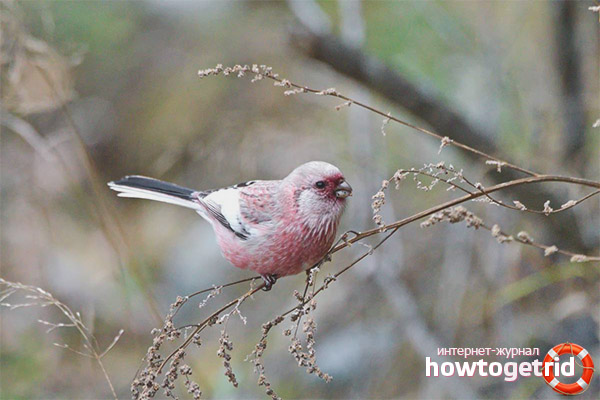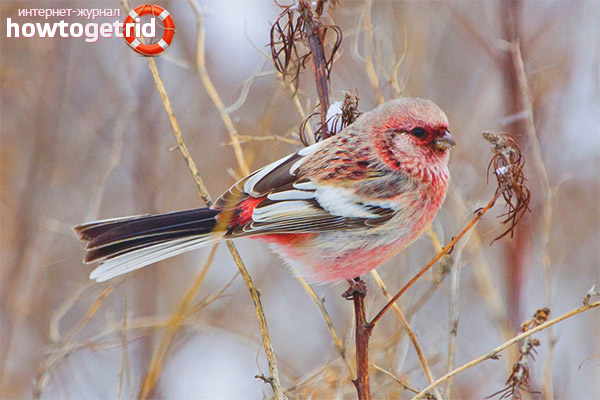The content of the article
Uraghus bird belongs to the family finch. The species belongs to the genus of lentils. Uraghus resemble these birds, as well as bullfinches. For this they are popularly called the long-tailed bullfinch.
Appearance
These birds are almost the same size as a sparrow. Their body weight is 16-21 g. The length of the body of the hurragus reaches 20 cm. This length is due to the fact that the bird has a long tail. The wingspan of this small bird is about 24 cm.
These birds are quite easy to distinguish from others. This is especially true of males. They have a bright plumage. In particular, they stand out in the winter against the backdrop of snow. On the head and neck, the plumage is painted in a reddish color. The tail and wings have contrasting plumage in a combination of black and white. Small silver spots are visible on the chest and head of the hurragus.
Fact! The greater the male’s age, the more vivid the color becomes.
In females, the plumage is not so bright. Their body is covered with gray feathers. Sometimes reddish and black blotches come across. Young feathers of both sexes have the same plumage. The beak of these birds is yellowish-brown. It is small in size. A distinctive feature of the appearance of the hurragus is its large tail, which they use to control flight.
Nutrition
Habitat
A lot of these birds live in Asia. They can be seen in countries such as China, Korea, Mongolia, etc. Hurricanes also live in southern Siberia. In recent years, the habitat of this species has shifted somewhat. They are found in regions located west of their usual habitat. Sometimes they fly to the west of Europe.
They do not fly away for the winter, but belong to wandering birds. They remain in place only when they build a nest, hatch and feed offspring. They usually build a nest in the bush. They roam in small groups, sometimes in pairs. Most often, they fly from place to place along a river valley or railway.
Subspecies
There are 3 subspecies of these birds. Each of them lives in a certain territory. They differ from each other in their size.
- The ordinary hurragus. Representatives of this subspecies live in the eastern regions of Russia. This is the most common subspecies. Ordinary hurrages are the largest compared to the rest. The length of their tail is about 9 cm, and the wings are up to 8 cm.
- Ussuri. You can meet him in the Amur region, as well as in the Ussuri basin. This subspecies is medium in size. They are slightly smaller than ordinary and Japanese hurragus. The length of the tail and wings is the same - about 7 cm or a little more.
- Japanese. The habitat of the subspecies is Japan and Sakhalin. Sometimes they can also be found on the Kuril Islands. These birds are the smallest. The length of the tail is about 8 cm, and the wings reach a length of 6-6.4 cm.
Gender differences
This species is characterized by sexual deformism. The male can be seen in bright colors, while the females have gray plumage. There are very few bright inclusions on it. But at a young age, everyone has the same color. Males become brighter only by the age of 3 months. If you keep a bird at home, the male may lose all its beautiful coloring.After molting, he often grows the same gray feather as that of females.
Content
These birds are quite peaceful and friendly, they sing beautifully. Therefore, many keep them at home. Sometimes one bird lives in a cage. Some contain them in pairs.
Cell
To start a house at home, you need to prepare a cage for it at least 80 cm long and almost the same width. It is recommended to install it in such a place to provide the bird with natural light. The cage should be with vertical bars. In it you need to put a few poles with tree bark, about which the bird can sharpen its claws.
For the female, it is necessary to make something like a house that can serve as a shelter for her. She will use it during the nesting period. She should have a place where she can hide from the male, as they can behave aggressively. In addition, it is necessary to equip a place for swimming.
Feeding
Since birds in nature feed on grain and seeds, feeding them is easy. The usual mixture for canaries is quite suitable, in which there are seeds of plantain, dandelion and other wild herbs. It is additionally recommended to give them berries, greens. And when the birds nest, they need to give insects. Since their beak is small, the feed should be chopped. They need to change water as often as possible.
Breeding

When kept in a cage, these birds can also bring offspring. The female lays about 4 eggs of bluish color. The incubation period is about 2 weeks. Parents take care of the chicks for about 20 days.
Interesting Facts
- Birds adapt well to cage content. Concern is shown only during the first few days.
- Peacefully they behave only with representatives of their kind. And with the rest of the birds, they can even fight. Therefore, they should be kept separately.
- With the beginning of the nesting period, the male is usually inclined to show aggression. Therefore, the female should have reliable shelter.
- These birds can quickly gain weight. Therefore, you need to feed them a little.
Singing
Ugaruses sing quite melodically. This is what attracts bird lovers. In the hurrages themselves, the singing is pretty monotonous, but they are able to copy the sounds that other birds make. The singing of males is more beautiful, they can bring trills.
Video: hurragus (Carpodacus sibiricus)











Submit